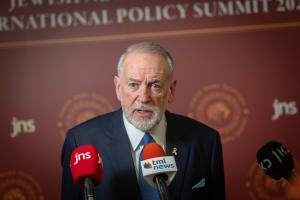Who cares about the anti-Hamas protests in Gaza

Over 3-4 consecutive days this past week, Gaza has witnessed an unprecedented wave of demonstrations by what appear to be average Gazan civilians against Hamas, the Islamist terror group that has ruled the enclave since 2007. Estimates differ about how many have been involved each day or cumulatively, but estimates are that thousands of Palestinians have taken to the streets, chanting slogans and with handmade signs like “Hamas does not represent me,” and “The people demand the toppling of Hamas.” Because of the Hamas’ terrorists mafia-like grip on Gaza, protesters may be risking their lives to oppose a regime known for its brutal suppression of dissent, or anything seen controverting its strict, jihadi Islamic ideology.
Indeed, there are reports now of armed Hamas terrorists threatening, beating, and even killing protesters, and blaming the protests on Israel as they conflate the protestors with Israeli collaborators.
These protests, occurring amidst an ongoing war and renewed Israeli military combat, signal a potential turning point in Palestinian “resistance”—not against Israel, as Hamas, other Iranian-backed proxies and many Western narratives often frame it, but against Hamas itself. However, the interpretation of these events reveal a stark divide in perspectives: on one hand there is the lack of Western media attention; and on the other hand the selective outrage of Western “pro-Palestinian” activists only demonstrating against Israel, and not against the actual threats and destruction caused by Hamas. All this is in the context of social and ideological undercurrents reflected in polls and actions showing wide support for Hamas’ brutal October 7, 2023, attack, massacre, and kidnapping among Palestinian Arabs.
Hamas’s first official response to these protests, as reported, exemplifies what appears to be desperation and weakness. The group has accused Israel of orchestrating the demonstrations, labeling them an “incitement campaign” against the “resistance.” It has cautiously acknowledged the protesters’ frustrations, attributing them to war-induced suffering rather than genuine anti-Hamas sentiment, while subtly threatening dissenters through its “resistance security” apparatus’ internal civil control of its broader terror operations. This rhetoric underscores Hamas’ precarious position: it lacks the infrastructure to jail or systematically suppress such large-scale unrest, yet it cannot afford to lose face by cracking down violently on its own people. Instead, it seeks to redirect the narrative, urging protesters to focus their anger solely on Israel—a strategy that aligns with its historical deflection tactics but seems increasingly untenable as Gazans equate Hamas with the war’s devastation.
Suggestions have been made that Hamas’ apparent recent willingness to enter into another ceasefire that will see the release of more of the 59 hostages still in their captivity is to give them the ability to focus on putting down the protests rather than having to fight Israel.
In contrast, the Western media’s response—or lack thereof—has been glaring. While visual evidence of the unprecedented wave of thousands protesting across Gaza, mainstream media outlets have downplayed the scale, reporting mere “hundreds” of demonstrators, or the potential significance of the population beginning to rise up against Hamas. This minimization reflects a broader reluctance to disrupt the entrenched “resistance” narrative that frames Hamas as a legitimate voice of the Palestinian Arabs' “struggle” against Israel. Outlets like Al Jazeera, widely criticized as a mouthpiece for Hamas, have been accused of ignoring or distorting these events to protect the group’s image. The absence of any robust press coverage not only obscures the courage of Gazan protesters but also perpetuates a one-dimensional portrayal of the conflict, sidelining the internal Palestinian Arab dynamics at play. Further, it limits the possible widening of the protests as being something potentially mainstream.
This selective attention extends to the supposed “pro-Palestinian” movement in the West, particularly evident in protests and campus activism. In Washington, D.C., and on U.S. college campuses, demonstrators continue to chant anti-Israel slogans, obliviously disregarding those Gazans risking their lives to oppose Hamas. Confronting the often antisemitic and genocidal nature of alleged “pro-Palestinian” demonstrations, such demonstrators are being challenged that if they are truly “pro-Palestinian” their focus should be on how Hamas harms Palestinian Arabs, with the proof text of the very demonstrations that are taking place and the threat to the lives of those demonstrating.
This reveals the dishonesty of people more invested in an anti-Israel agenda than in supporting the genuine well-being of the Palestinians, especially when protests target an Islamist group responsible for decades of oppression. Signs in Gaza reading “Hamas is a terrorist” and pleas for peace go unacknowledged by the alleged “pro-Palestinian” activists, who appear to prioritize ideological hatred of Israel over the actual well-being of Gazans.
Yet the hopeful signs must be tempered by sobering realities. Banners proclaiming, “Hamas does not represent me” and chants demanding an end to the terror group’s rule suggest a burgeoning resistance within Gaza, seeking liberation from Hamas’ grip. However, this shift may be more strategic rather than ideological. Polls conducted since October 7, 2023, consistently show over 80% of Palestinian Arabs in Gaza and the “West Bank” (Judea and Samaria) approving of the Hamas massacre, which saw Gazan civilians along with Hamas terrorists participate in murder, rape, and looting.
Eyewitness accounts and footage reveal Gazan civilians cheering as hostages were paraded through the streets, and many hostages later reported being held captive in civilian homes. Seventeen months later, as Israel cuts humanitarian aid in response, these protests may reflect a pragmatic awakening to the consequences of such actions, rather than a rejection of the underlying genocidal anti-Israel ideology with which they have been indoctrinated for generations.
Amid the protests, one needs to avoid a naïve misinterpretation of the protests as progress. While the opposition to Hamas’ tyranny may be real, there is no evidence that average Gazans have had a change of heart, but rather that they remain committed to the destruction of Israel. In this view, the protests are less a moral evolution than a self-serving reaction to Hamas’ failures, with the same “butchers and rapists” now facing the rubble of their own making. This perspective casts the demonstrations as a tactical pivot, not a renunciation of the hatred that fueled the massacre. It underscores that the true solution for peace in Gaza must be a wholesale ideological change. There is no evidence of this in any of the protests.
There’s a contradiction that must be laid bare between those who see a glimmer of hope in Gazans protesting against Hamas, and those who see only enduring enmity, with the protests attempting to rescue Gazans from Hamas, but without lessening their ideological hatred of, nor threat to, Israel. The lack of press coverage, the disingenuousness of “pro-Palestinian” activists, and the conflict between strategy and ideology all complicate these events. What remains clear is that Gazans are speaking, risking their lives to demand change. Whether the world listens, and how it interprets this, will shape the discourse around this unprecedented moment in history, and their future.

Jonathan Feldstein was born and educated in the U.S. and immigrated to Israel in 2004. He is married and the father of six. Throughout his life and career, he has become a respected bridge between Jews and Christians and serves as president of the Genesis 123 Foundation. He writes regularly on major Christian websites about Israel and shares experiences of living as an Orthodox Jew in Israel. He is host of the popular Inspiration from Zion podcast. He can be reached at [email protected].













